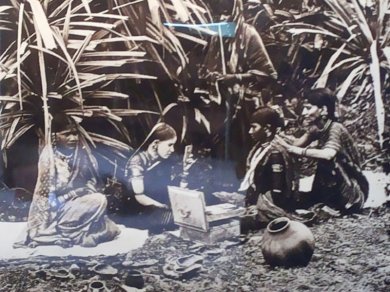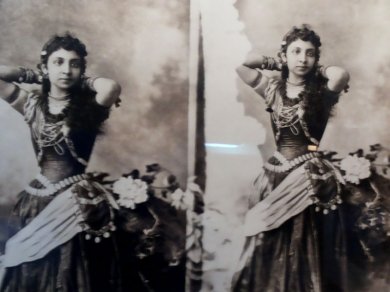
|   |

|   |
Veteran performances and bosom intensives: SPIC MACAY’s 2nd International Convention - Veejay Sai e-mail: vs.veejaysai@gmail.com June 30, 2014 The 2nd international convention of SPIC MACAY (SM) was held from June 8 to 14, 2014. Delegates from half a dozen countries including Pakistan, Mauritius, Sri Lanka, Afghanistan and more attended the hectic neck-breaking schedule in the serene green premises of IIT Madras. Year after year, the volunteers of SM grow exponentially, making it the world’s most vibrant cultural movement. It is also completely managed by students with the spirit of volunteerism. This makes SM the youngest movement in the world. What started off as a movement to take only Indian classical music to youngsters soon spread its wings to dance, theatre, film, folklore, handicrafts, handlooms and what have you! This year at the convention, the dance segment had a mixed variety of performances and intensive courses. Slide show Performances at the 2nd Spic Macay International Convention Photos: Lalitha Venkat                                      The crammed-weeklong calendar had a sparse presence of dance performances. The first one on the list was the performance of veteran Bharatanrityam dancer Dr. Padma Subrahmanyam minus her signature curls. Padma opened her performance with a Thodayam followed by a Ganesha Kautuvam. The story of Ganesha having swallowed Vishnu’s Sudarshana Chakra and Vishnu’s antics to retrieve it from Ganesha was told in the highly dramatic fashion by Padma. With disco lights to support her choreography, she put in much effort on stage. In her second piece, a Thevaram ‘Thiru Anga Maalai’, Padma’s group of dancers made a filmy entry and displayed much-rehearsed synchrony. While Gayathri Kannan’s sweet singing could be heard softly in the piece, the other singer’s off-pitch singing dominated the piece. In a pantomime of a performance, Padma entered from the wings as Shiva in this form of ‘Ardhanarishwara’. Choreographing Muthuswamy Dikshitar’s famous composition set to Kumudakriya ragam, Padma seemed to have condensed the movements to suit her age. Filled with unfinished movements and at a hurried pace, this item too came across as a disappointment. Following this was an extra-long Varnam inspired by Bharatiyaar’s composition. The fast-forwarded adavus seemed out of place for Padma’s slow motion treatment of the piece. With highly contrived sancharis and theatricality, the piece managed to sail through before a couple more pieces. She ended her performance with an Annamacharya keerthana ‘Thandanana Bhala Thandanana’. Once again, choosing a composition that wasn’t really meant to be danced to, the choreography of the piece became forced every time she did ‘Okkate! Okkate!’ By the end of the show Padma had a hall full of students eating out of her hands with a huge round of applause. One wondered what about her performance, did it get across to the children in the hall? Did all of them understand everything she did? Or was it an engineered applause fed into the psyche of kids that they must clap after every show (which they eventually did through the course of the shows in the convention). Padma had the knack of communicating and keeping them entertained, be it with the selection of pieces or the way she performed. One must credit her for catering to her audience and getting applause but one also wishes a dancer with her seniority observed more caution. The performance schedule of the convention announced a dance recital by Alarmel Valli. Due to a medical emergency in her family, she withdrew from performing. That slot was filled in by veteran Guru C V Chandrashekar, who was till then designated only to take intensives. His rendering of the famous Todi Varnam ‘Roopamu Joochi’ had the hall once again erupt into applause. CVC, as he is fondly referred to, can give men half his age a run for their money with his dance. A greatly inspiring performance left the hall of children highly enthusiastic. Pt Birju Maharaj’s performance on the last all-night festival ended up being an exercise in repetition. Every year, the Kathak maestro and his prime disciple Saswati Sen are invited to the conventions. Every year they put together more or less the same pieces. As a convention regular senior Spic Macay volunteer reeled off in a prediction before the concert “an opening piece, Saswati’s solo pieces, Maharaj-ji showing a train, or birds and animals, a dialogue between two friends, a telephone sound and a jugalbandi between the two.” After the performance one felt that the volunteer couldn’t have been more appropriate in his forecast! If SM went into their own archives, they shouldn’t be surprised to find what all this fuss is about. Added to this was a senior in the wings who kept waving to the children to get up and welcome the artistes with huge applause before and after the show. What culture does this breed among children? And what is SM doing in the long run by engineering the psyche of future audiences to mindlessly clap for everything? Kids are not the diplomatic best when it comes to expressing themselves. They don’t need to be either. They speak their hearts out good, bad or ugly. Towards the end of the convention a young school kid asked, in all innocence, “Is it important that all dancers have to be very aged so they can perform? Sab budde log hi naachte hai kya (do only oldies dance?)”. While the response was a loud laugh, the sarcasm in the comment was hard-hitting. What message is SM finally giving these kids.  Performers  Dancing girl
Photos by Raja Deen
Dayal
In the foyer of the main auditorium was a rather shoddily
curated photography exhibition of Raja Deen Dayal’s old
prints put together by the IGNCA. While the intention of
this was excellent, it served less purpose to hang out a
series of images without providing any details or have any
experts give a talk as to why was that show important for
all the kids there. Two images from the series were
connected with dance. One was a dancing girl from the
Hyderabad Nizam’s harem and another was an image of what
seemed like a group of dancers or performers getting ready
in a makeshift green room. These two fascinating images
had rich stories behind them for sure! If only the
audiences was allowed to know with the help of a
well-informed curator. It was a welcome gesture for
SM to have collaborated with photography segment as well.
One hopes their future such collaborations would be more
fruitful, informative and generate further curiosity among
youngsters attending the convention.The intensives this year were a mixed bag too. Pondicherry based Odissi dancer Sangeeta Dash, Mohiniattam dancer Gopika Varma, Kuchipudi by Vyjayanthi Kashi, Kathak by Malabika Mitra and Bharatanatyam by Guru CVC. On an afternoon of faulty programming and filling in slots, a few of the intensive gurus were asked to give short 15 minute lec-dems. Sangeeta showed a few abc’s of her dance form and continued into a short abhinaya piece with the theme of a sakhi telling the nayika about Krishna’s playfulness. Gopika Varma decided to show the kids in the hall an excerpt from Jayadeva’s ‘Gita Govindam’ with all her hair drawn to one side. The helpless kids sat and saw Lord Krishna craving for the bosom of Radha in the ashtapadi “Chandana Charchita” as Gopika dripped shringaram all over. When will dancers learn to know who their audiences are before they blindly perform the wrong pieces at the wrong kind of events? While one doesn’t want to sound like a moral police at any cost, the important question is to ask if dancers have the discretion as to what they present, when and where at what kind of occasion. Following that was Vyjayanthi Kashi’s presentation that stretched on forever! Once again the kids witnessed Lord Krishna killing the demon Poothana in yet another woeful bosom staging. It was a late afternoon and the already worked-up and hungry kids sat there as a captive audience as Vyjayanthi seemed to have gotten lost and carried away in her own presentation. The only short and sweet lec-dem that made any sense was Malabika Mitra who showed a few of the Kathak pieces she learnt from her gurus. On request, she performed the Kali Padhanth, sticking to time. Dance is an intimate experience and if it is not delivered in the right way to audiences, it can lose its meaning very soon. The seating arrangements made to watch the performances seemed extremely unfriendly, to both the kids and to the artists whose attempt to show any good art went unnoticed. 2nd International Convention of SPIC MACAY at Chennai - Intensives in crafts, music and dance Text & Photos: Lalitha Venkat Overall, the dance segment of the convention stood out for its outright falling standards. It is high time SM revise their artiste list. The North East segment was totally ignored in every possible way when it came to dance. All along SM has kept their rule of presenting only SNA awardees. Is there a shortage of any such awardees from Manipuri, Sattriya and the like? Every year the SNA awards Bismillah Khan Yuva Puraskaar to many dancers and over the years there is a long drawn list of them who are never presented. A senior volunteer told us that since SM focused mostly on music, their dance programming was facing the side effects. If that be the case, why can’t they consult some experts and scholars? Senior critics like Leela Venkataraman, Manjari Sinha, Ravinder Mishra and Dr. Sunil Kothari have all been long standing supporters to the noble intent and cause of SM - all of them more than willing to guide the organization, just a call away. We hope SM would audit their performances, convention after convention. Else the chances of these events turning into large picnics and being totally detached from the actual intention of SM’s cause are highly likely. That would be a sorry state of affairs to deal with. As senior scholar and critic Leela Venkataraman wrote in the convention souvenir, “SPIC MACAY is working at exposing the young to those spaces which only art can reach.” For this great achievement to be realized, SM needs to work far more cohesively than it is at this point. Wishing them a great convention next year at the IIT-Bombay Campus in Mumbai. Let that be another chance to truly experience India’s rich heritage and culture through the services SM has been doing. Veejay Sai is a writer, editor and a culture critic. |